VVAM Newsletter 9 – 1983
Vrienden van het Airborne Museum
SOCIETY OF FRIENDS OF THE AIRBORNE MUSEUM OOSTERBEEK
Utrechtseweg 232, 6862 AZ Oosterbeek, Netherlands
Representative in Great Britain: Mr.A.Maynard, M.B.E.
Glenfarg Road, Catford, London SE 6 1XN
Tel.: Ol.698.8969
NEWS-LETTER No. 9- February I983
Editor: Drs.R.P.G.A.Voskuil Dutch-English translation: S.G.Beek-Hobart
Dear Friends,
As we approach the Annual General Meeting, which is to take place in March, this would seem to be an appropriate moment to clarify the relationship between the Airborne Museum and our Society. It is apparent from various conversations and questions, that many are not adequately aware of the difference between the “Stichting Airborne Museum” (Airborne Museum Foundation) and the “Vereniging Vrienden van het Airborne Museum” (Society of Friends of the Airborne Museum Oosterbeek).
The Foundation came into being in order to help keep up the Airborne Museum. The Foundation’s Committee manages the Museum and determines the way in which the internal and external matters and activities are to be run.
The Society’s activities are particularly directed towards encouraging interest in the Airborne Museum and the giving of assistance and support to the Airborne Museum Founda¬tion, when possible and desirable, It must be emphasised that the Society is not involved in the management or organisation of the Airborne Museum.
Through our Adviser, Major W.J.M.Duyts, who is also Secretary of the Foundation’s Committee, contact is maintained with both of the Committees.
Between the Committees of the Foundation and the Society there is a bond of friendship, but nevertheless each one functions independently and has its own responsibility. As a friend, our Society may give advice, make suggestions and, if necessary, offer material or personal help. As a friend, the Foundation’s Committee can either accept or reject our suggestions, offers etc. in part or in their entirety. The reverse of course also applies. I hope that this clarifies all doubts on the subject. I look forward to meeting you all at the
Annual General Meeting. Drs.J.Smits, Chairman.
The Third. Annual General Meeting of Members which will take place on the 12th March, 1983.
We have pleasure in inviting you to the Third Annual General Meeting of the Society of Friends of the Airborne Museum, which will take place on Saturday, 12th March, at 2 p.m. in the Concert Hall opposite the Old Church on the Benedendorpsweg in Oosterbeek.
The Agenda for the afternoon is as follows:
1. Opening of the Meeting
2. Minutes of the 2nd Annual General Meeting of 20th March, 1982
3. Annual Report 1982
4. Financial Report 1982 and Budget for 1983
5. Election of new Committee members
6. Appointment of members of the Cash Committee
7. Any further business
8. Members retiring from the Committee
9. Closing of the Meeting.
With respect to No. 5: According to the Resignation Roster, Mrs.J.Smit-Duchateau and Mr.J.A.Eykelhoff are to resign their positions; Mrs.J.Smit-Duchateau is not available for re-election.
The Committee presents the following candidates:
a. Mr.J.A.Eykelhoff
b. Mr.C.van Roekel, Benedendorpsweg 119, Oosterbeek. numbers and
According to Article 8 of the Statutes, candidates can be presen e y writing,
Committee. Candidates presented by the members should follow this p o .
at least 10 days before the Meeting, delivered to the afore-mentione r , , 0
Secretary of the Society. This should be accompanied by the signatures o a members. The candidates must themselves be members of the Society, they mus and they must also supply a written agreement with respect to their candi acy. Half-an-hour before the Meeting commences, the report of the Cash Committee will be available for perusal.
The film entitled “Airdrop at Arnhem” will be shown after the Annual General Meeting on the 12th March.
The commentary of this American documentary film, which takes about half-an-hour, is given by the well-known American C.B.S. reporter, Walter Cronkite. As a young war¬correspondent in September 1944, Cronkite covered the landings of the 101st American Airborne Division near Eindhoven.
Annual Report for 1982.
The number of members of the Society of Friends of the Airborne Museum Oosterbeek greatly increased in 1982. On the 31st December, I982, the Society had 483 members both at home and abroad (374 last year).
The Second Annual General Meeting on the 20th March 1982 was attended by 99 members, including Mr.A.Maynard, M.B.E., who is our representative in Great Britain. For an ex¬tensive report of this Meeting, please see Newsletter No. 6, June 1982.
Four News-Letters were sent to the members in 1982 in both Dutch and English. The English translations were done by Mrs.S.G.Beek-Hobart (3 issues) and Mr.A.Groeneweg (1 issue).
Two Special Afternoons were organised on the 26th June and the 20th November respectively. On the 26th June, Messrs. Groeneweg, Van Roekel and Voskuil organised a walk through Oosterbeek, giving special attention to some of the places where heavy fighting took place during September, 1944, On the 20th November, Mr.W.Boersma gave a talk about the radio communications during the Battle of Arnhem, followed by two films.
Both afternoons were very well-attended with 120 and 160 members respectively.
The death of Mr.P. Ch.Schi jf.
We have been informed of the death of Mr.P.Ch.Schijf of Arnhem. Mr.Schijf was a member of our Society.
A new photo-book about the war-battered villages of the Southern Veluwe.
In August 1980, a photo-book was published entitled, “Oosterbeek Verwoest, 1944-1945” (“Oosterbeek Destroyed”) compiled by G.H.Maassen. One can see from the photographs how enormous the devastation was in Oosterbeek, where the major part of the Battle of Arnhem took place. But also the other nearby villages suffered heavily, and there are also photographs in existence showing this. Some of these photos have been bundled together and now form a new book, compiled by G.H.Maassen, entitled “Vier geschonden dorpen, Doorwerth/Heveadorp, Heelsum, Renkum, Wolfheze in 1945” (Four Devastated Villages in 1945 – Doorwerth/Heveadorp, Heelsum, Renkum, Wolfheze)(freely translated (S.B.-H.) and not yet in English).
The damage to these villages and neighbouring countryside was mainly a result of the Allied bombardments of the German line of defence situated on the Southern Veluwe The looting and senseless destruction of houses and buildings also contributed towards the cheerless scene in 1945- The photographs ate described with great care, and not onlv are the locations given with as much exactitude as possible, but other points of when relevant, are also mentioned. F 1 lnreresib
“Vier Geschonden Dorpen” is published by “Hoog en Laag B.V.”, Oosterbeek And f 17.-. The book is also available at the Airborne Museum.
ASSETS BALANCE as of 3ist December, 1982 (DOWNLOAD letter)
f 16.199,67 f 16.199,67
BUDGET 1983
DEBITS CREDITS
f 8.900,—
A new edition of Frost’s book. “A Drop Too Many”.
In 1980 John Frost’s book, “A Drop Too Many” was published, describing his experiences during the Second World War. Now a second and supplementary edition has been published. When war broke out Frost was in Iraq. When he returned to England, he became a para¬trooper. He became’widely known in February 19^2 when he successfully led a parachute attack on a radar station near Bruneval situated on the French coast.
In September 19^2 Frost as Commander of the 2nd Battalion of Paratroopers, took part in the first major airborne operation in Northern Africa. Afterwards, Frost’s 2nd
Battalion ‘became part of the airborne troops who landed on the Italian island of Sicily in July 1943. A period of training then followed in England.
On the 17th September, 1944, together with his Second Battalion, Frost parachuted down onto the fields nearby Wolfheze. On that same evening, he and his men arrived at the traffic-bridge in Arnhem. On the next day, he led the defence of the small bridge-head around the northern ramp against the German attacks. And there was no relief from either the Second Army or the remainder of the First British Airborne Division.
Frost was wounded on Wednesday, 20th September, and was taken a prisoner-of-war. He returned to England after the Liberation, and this is where the first edition of his book finishes.
In the second edition, Frost has added a few chapters about the post-war period, the annual Commemorations in Arnhem and the filming of Ryan’s book, “A Bridge Too Far”, in which he acted as adviser.
In the final chapter, which he calls “Last Thoughts”, Frost considers some of the mis¬takes which to his idea were part and parcel of the failure of the Battle of Arnhem. Although Frost’s book is of course primarily his personal story, it can nevertheless be also considered as an historical version of the 2nd Battalion Paratroopers during the war years. This second edition, published in 1982 by Buchan & Enright, London, costs f 48.- in the Netherlands,
Hartenstein’s safe opened after forty years.
On Saturday, 30th October of last year, in the cellars of Hartenstein, the steel door of the safe was finally opened after an operation which took over twelve hours.
The door had not been opened for about forty years because the key was lost at the beginning of the war.
During the war, the Germans had tried to open the steel door with explosives, but this had failed, only leaving the door and the steel rabbet out of alignment. They then hacked a hole in the side wall of the safe, after which the steel inner plate could be removed. This space allowed them to rifle the safe.
In October of last year, this same space was again used in order to get into the safe. Wim van der Hoogen, a lock-specialist from Arnhem, had to saw – standing in the safe itself – the fire-proof inner door open in order to reach the lock mechanism. But even when this mechanism had been released, the door still refused to budge because it was completely jammed in the rabbet.
Wim van der Hoogen, Martijn Toebosch of the firm Van Amerongen in Arnhem and Berry de Reus spent many hours using high-pressure apparatus trying to get the door open, which eventually gave way after a great deal of labour.
The safe-door will novi be repaired and given a new lock. The safe has been completely cleaned up and will in future be used for keeping the archives.
Colonel Geoffrey Powell’s book about “Operation Market Garden” which is in preparation.
Colonel Geoffrey Powell (Retired) is busy collecting material for a new book about “Operation Market Garden”, Powell has already visited the Airborne Museum in Oosterbeek and gone through various reports and photographs. He has also visited Nijmegen and Eindhoven.
In September, 1944, Powell was Company-Commander of the “C” Company of the 156th Para¬troopers Battalion, who parachuted onto the Ginkel Heath on the 18th September, 1944, and consequently took part in the fighting in Oosterbeek.
Using the pseudonym of “Tom Angus”, he published “Men at Arnhem” in 1976. The Dutch translation appeared in 1979, entitled, “De Helden van Arnhem”, which was published together with the book written by Lipmann Kessel and John St.John entitled “Een Chirurg valt uit de lucht”; these two books were bound as one, entitled “Van de Kernel in de Hel” and published by Omega Boek, Amsterdam.
Powell’s new book about “Market Garden” will be published in 1984.
News-letter No. 10.
The next News-letter will appear in May or June, 1983.
R.P.G.A. Voskuil,

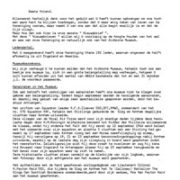
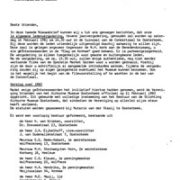
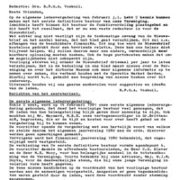
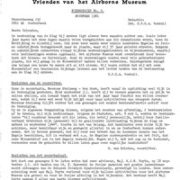
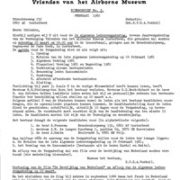
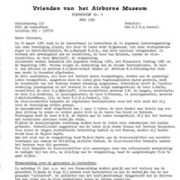
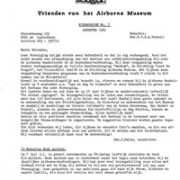
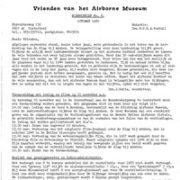


Plaats een Reactie
Vraag of reactie?Laat hier uw reactie achter.